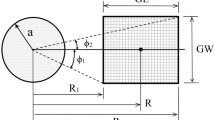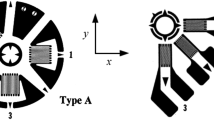Abstract
Background
The radial design for strain gauge rosettes used for hole-drilling residual stress measurements was established over 50 years ago and has remained almost unchanged since then. The design was developed to promote strain sensitivity, but was made without regard for ability to identify interior stresses. Consequently, only near-surface residual stresses can be identified.
Objective
The aim of this study is to investigate rosette geometric features that may be refined to enable a significant increase in ability to identify interior stresses without significant loss of strain sensitivity.
Methods
A finite element analysis was undertaken to model the influence of various geometrical factors on the depth response of a strain gauge rosette.
Results
It was found that that circumferentially oriented strain gauges allow residual stress measurements to be made to twice the depth of traditional radial strain gauges, with only minor loss in strain sensitivity.
Conclusions
A new circumferential strain gauge rosette design based on the presented analysis is proposed for use where extended depth measurements are desired.











Similar content being viewed by others
References
ASTM (2013) Determining residual stresses by the hole-drilling strain-gage method. Standard test method E837-13a. American Society for Testing and Materials, west Conshohocken, PA
Schajer GS, Whitehead PS (2018) Hole-drilling method for measuring residual stress. Morgan & Claypool, Williston
Grant PV, Lord JD, Whitehead PS (2002) The measurement of residual stresses by the incremental hole drilling technique. Measurement Good Practice Guide No.53, National Physical Laboratory, Teddington, UK
Vishay Measurements Group, Inc. (1993) Measurement of Residual Stresses by the Hole-Drilling Strain-Gage Method. Tech Note TN-503-6. Vishay Measurements Group, Inc., Raleigh, NC. 16pp
Mathar J (1934) Determination of initial stresses by measuring the deformation around drilled holes. Trans Am Soc Mech Eng 56(4):249–254
Soete W, Vancrombrugge R (1950) An industrial method for the determination of residual stresses. Proceedings SESA 8(1):17–28
Boiten RG, ten Cate W (1952) A routine method for the measurement of residual stresses in plates. Appl Sci Res A3(5):317–343
Kelsey RA (1956) Measuring non-uniform residual stresses by the hole drilling method. Proceedings SESA 14(1):181–194
Riparbelli C (1950) A method for the determination of initial stresses, Proceedings SESA, 8:173-196
Rendler NJ, Vigness I (1966) Hole-drilling strain-gage method of measuring residual stresses. Exp Mech 6(12):577–586
Bijak-Zochowski M (1978) A Semidestructive method of measuring residual stresses. VDI-Berichte 313:469–476
Schajer GS (1988) Measurement of non-uniform residual stresses using the hole-drilling method. Journal of Engineering Materials and Technology 110(4) Part I:338-343, Part II:344-349
Love AEH (1927) A treatise on the mathematical theory of elasticity. Cambridge University Press, Cambridge
Schajer GS, Prime MB (2006) Use of inverse solutions for residual stress measurements. J Eng Mater Technol 128(3):375–382
Schajer GS (2020) Compact calibration data for hole-drilling residual stress measurements in finite-thickness specimens. Exp Mech 60:665–678
Schajer GS (1993) Use of displacement data to calculate strain gauge response in non-uniform strain fields. Strain 29(1):9–13
Schajer GS, Tootoonian M (1997) A new rosette design for more reliable hole-drilling residual stress measurements. Exp Mech 37(3):299–306
Beghini M, Bertini L, Giri A, Santus C, Valentini E (2019) Measuring residual stress in finite thickness plates using the hole-drilling method. J Strain Anal Eng Des 54(1):65–75
Acknowledgments
Dr. Philip Whitehead, Stresscraft, UK, gave much encouragement and advice. Prof. R. L. Taylor kindly provided the PCFeap software used for the finite element calculations.
Funding
This work was financially supported by the Natural Science and Engineering Research Council of Canada (NSERC).
Author information
Authors and Affiliations
Corresponding author
Ethics declarations
Conflict of Interest
The author declares that he has no conflict of interest.
Additional information
Publisher’s Note
Springer Nature remains neutral with regard to jurisdictional claims in published maps and institutional affiliations.
Rights and permissions
About this article
Cite this article
Schajer, G.S. Circumferential Rosette Design for Extended Depth Hole-Drilling Residual Stress Measurements. Exp Mech 60, 1265–1274 (2020). https://doi.org/10.1007/s11340-020-00660-y
Received:
Accepted:
Published:
Issue Date:
DOI: https://doi.org/10.1007/s11340-020-00660-y




